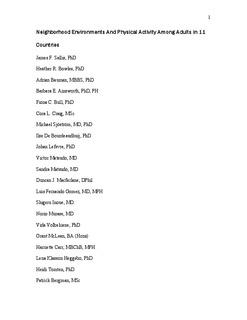Neighborhood environments and physical activity among adults in 11 countries
Sallis, James F.; Bowles, Heather R.; Bauman, Adrian; Ainsworth, Barbara E.; Bull, Fiona C.; Craig, Cora L.; Sjöström, Michael; de Bourdeaudhuij, Ilse; Lefevre, Johan; Matsudo, Victor; Matsudo, Sandra; Macfarlane, Duncan J.; Gomez, Luis Fernando; Inoue, Shigeru; Murase, Norio; Volbekiene, Vida; McLean, Grant; Carr, Harriette; Klasson-Heggebø, Lena; Tomten, Heidi; Bergman, Patrick
Journal article, Peer reviewed
Permanent lenke
http://hdl.handle.net/11250/170549Utgivelsesdato
2009-06Metadata
Vis full innførselSamlinger
- Artikler / Articles [2096]
Originalversjon
American Journal of Preventive Medicine. 2009, 36(6), 484-490Sammendrag
Background: Understanding environmental correlates of physical activity can inform policy changes. Surveys were conducted in 11 countries using the same self-report environmental variables and the International Physical Activity Questionnaire, allowing analyses with pooled data. Methods: The participating countries were Belgium, Brazil, Canada, Colombia, China (Hong Kong), Japan, Lithuania, New Zealand, Norway, Sweden, and the U.S., with a combined sample of 11,541 adults living in cities. Samples were reasonably representative, and seasons of data collection were comparable. Participants indicated whether seven environmental attributes were present in their neighborhood. Outcomes were measures of whether health-related guidelines for physical activity were met. Data were collected in 2002–2003 and analyzed in 2007. Logistic regression analyses evaluated associations of physical activity with environmental attributes, adjusted for age, gender, and clustering within country. Results: Five of seven environmental variables were significantly related to meeting physical activity guidelines, ranging from access to low-cost recreation facilities (OR=1.16) to sidewalks on most streets (OR=1.47). A graded association was observed, with the most activity–supportive neighborhoods having 100% higher rates of sufficient physical activity compared to those with no supportive attributes. Conclusions: Results suggest neighborhoods built to support physical activity have a strong potential to contribute to increased physical activity. Designing neighborhoods to support physical activity can now be defined as an international public health issue.
Beskrivelse
I Brage finner du siste tekst-versjon av artikkelen, og den kan inneholde ubetydelige forskjeller fra forlagets pdf-versjon. Forlagets pdf-versjon finner du på www.sciencedirect.com: http://dx.doi.org/10.1016/j.amepre.2009.01.031 / In Brage you'll find the final text version of the article, and it may contain insignificant differences from the journal's pdf version. The original publication is available at www.sciencedirect.com: http://dx.doi.org/10.1016/j.amepre.2009.01.031
